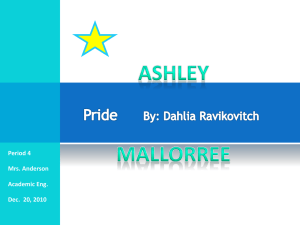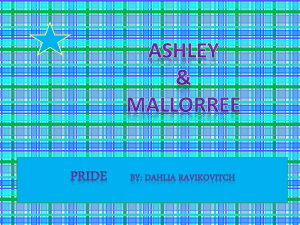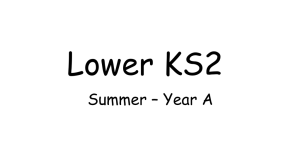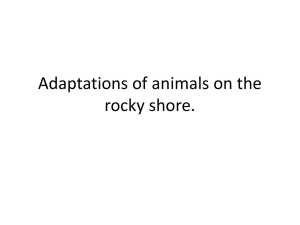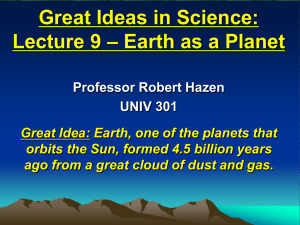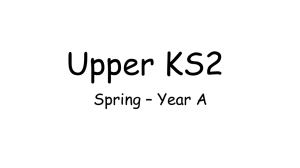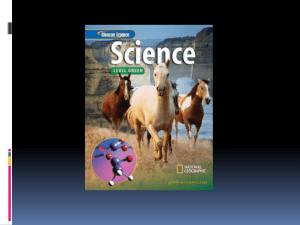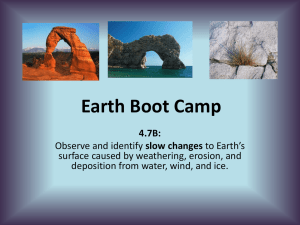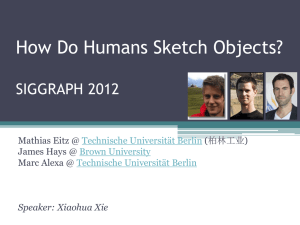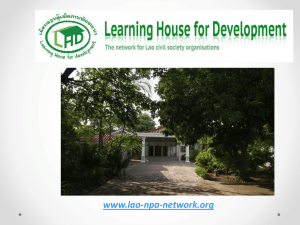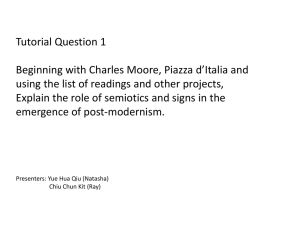LKS2 Year A Autumn
advertisement
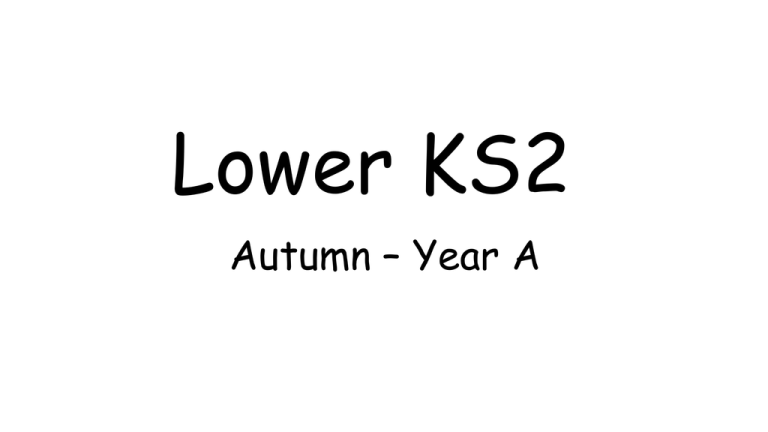
Lower KS2 Autumn – Year A Science Year 3: How far can you throw your shadow? Year 3: Science, Art and DT Knowledge, Skills and Understanding Science - Light • • • • • • • Art & Design Can they make and record a prediction before testing? Can they measure using different equipment and units of measure? Can they record their observations in different ways? (labelled diagrams, charts etc.) Can they describe what they have found using scientific words? Can they make accurate measurements using standard units? Can they explain what they have found out and use their measurements to say whether it helps to answer their question? Can they explain what dark is using words like shadow? • • • • • • • • • Year 3 (Challenging) • • • • • Can they record and present what they have found using scientific language, drawings, labeled diagrams, bar charts, keys and tables? Can they explain their findings in different ways (display, presentation, writing)? Can they use their findings to draw a simple conclusion? Can they explain why lights need to bright or dimmer according to need? Can they explain why their shadow changes when the light source is moved closer or further from the object? Can they predict with accuracy the colours that they mix? Do they know where each of the primary and secondary colours sits on the colour wheel? Can they create a background using a wash? Can they use a range of brushes to create different effects? Can they use their sketch books to express feelings about a subject and to describe likes and dislikes? Can they make notes in their sketch book about techniques used by artists? Can they suggest improvements to their work by keeping notes in their sketch books? Can they explore work from other periods of time? Are they beginning to understand the viewpoints of others by looking at images, people and understand how they are feeling and what the artist is trying to express in their work? Design Technology • • • • • • © Focus Education 2014 Can they show that their design meets a range of requirements? Can they put together a step-by-step plan which shows the order and also what equipment and tools they need? Can they describe their design using an accurately labelled sketch and words? How realistic is their plan? Can they use equipment and tools accurately? What did they change which made their design even better? 3 Year 3: How far can you throw your shadow? KS2 Science (Y3 Light) • • • • • recognise that they need light in order to see things and that dark is the absence of light notice that light is reflected from surfaces recognise that light from the Sun can be dangerous and that there are ways to protect their eyes recognise that shadows are formed when the light from a light source is blocked by a solid object find patterns in the way that the size of shadows change. WOW: Use torches to create different shapes and attempt to Working Scientifically: Set up a fair test to see what happens when there is more than one source of light and record findings. Looking for patterns in what happens to shadows when the light source moves or the distance between the light source and the object changes. photograph them. LC1 How can you show that your shadow changes according to the position of the Sun? LC2 Why do footballers in a night match often have four shadows? LC3 Numeracy Link: Children to measure the lengths of their shadows and to present their findings in graphical format Creative Art Link: Children to design and make periscopes, taking account of the light source How can you explain the relationship between the Sun and the Moon (in terms of lighting up the moon)? LC4 How can you design and make a periscope to show how light reflects? LC5 How can you set up an experiment to show how shiny things respond in the dark? LC6 Can you create a painting which shows reflection of light on water? LC7 Can you create a stained glass window which is translucent? LC8 Reflection: Put together a photo story of the completed challenge. Creative Arts Link: Children to look at the work of Turner and use water colour or acrylic paint to create the reflection on water. Creative Arts Link: Children to design and create their own stained glass windows having thought about their design. © Focus Education 2014 What makes a Shadow Clyde RobertBulla 4 Short Unit Year 3: What do rocks tell us about the way the Earth was formed? Year 3: Science and Art Knowledge, Skills and Understanding Science – Rocks Art & Design • Can they compare and group together different rocks based on their simple physical properties? • Can they describe and explain how different rocks can be useful to us? • Can they describe how fossils are formed? • Can they recognise that soils are formed from rocks and organic matter? • Can they add onto their work to create texture and shape? • Can they work with life size materials? • Can they use their sketch books to express feelings about a subject and to describe likes and dislikes? • Can they make notes in their sketch books about techniques used by artists? • Can they suggest improvements to their work by keeping notes in their sketch books? Year 3 (Challenging) • Can they classify igneous and sedimentary rocks? • Can they begin to relate the properties of rocks with their uses? © Focus Education 2014 5 Year 3: What do rocks tell us about the way the Earth was formed? (Linked to ‘What makes the Earth Angry?’) KS2 Science (Y3 Rocks) • • • compare and group together different kinds of rocks on the basis of their appearance and simple physical properties describe in simple terms how fossils are formed when things that have lived are trapped within rock recognise that soils are made from rocks and organic matter. WOW: Bring in a collection of rocks and let the children touch and talk about them. LC1 What are fossils and why are they so fascinating? LC2 What can you find out about sedimentary and igneous rocks? LC3 Why is a diamond a ‘girl’s best friend’? LC4 Can you collect some rocks to create a rock sculpture? LC5 Reflection: Can you work as a team to create a power-point presentation about rocks? © Focus Education 2014 Working Scientifically: Observing rocks, including those used in buildings and gravestones, and exploring how and why they might have changed over time; using a hand lens or microscope to help them to identify and classify rocks according to whether they have grains or crystals, and whether they have fossils in them. Literacy Link: Opportunities here for children to carry out individual research based on rock types, including fossils. Creative Art Link: Children to plan, design and make a rock sculpture using large, medium and small rocks. These should be photographed and used as part of their reflection presentations. Stone girl Bone girl Laurence Anholt Pebble in my pocket Meredith Hooper & Chris Cody 6 History Year 3 History Knowledge, Skills and Understanding Chronological understanding Knowledge and interpretation Historical enquiry • Can they describe events from the past using dates when things happened? • Can they describe events and periods using the words: ancient and century? • Can they use a timeline within a specific time in history to set out the order things may have happened? • Can they use their mathematical knowledge to work out how long ago events would have happened? • Can they recognise that Britain has been invaded by several different groups over time? • Do they realise that invaders in the past would have fought fiercely, using hand to hand combat? • Do they appreciate that wars have happened from a very long time ago and are often associated with invasion, conquering or religious differences? • Can they use various sources of evidence to answer questions? • Can they use various sources to piece together information about a period in history? • Can they research a specific event from the past ? • Can they use their ‘information finding’ skills in writing to help them write about historical information? Year 3 (Challenging) • Can they set out on a timeline, within a given period, what special events took place? • Do they have an appreciation that wars start for specific reasons and can last for a very long time? © Focus Education 2014 • Can they begin to use more than one source of information to bring together a conclusion about an historical event? • Can they use specific search engines on the Internet to help them find information more rapidly? 8 Year 3: Who first lived in Britain? KS2 History: Stone Age to the Iron Age, including: - Hunter gatherers; Early farming; Bronze Age, and Iron Age WOW: Share a presentation about the artefacts found related to the Ancient Britons and consider their purposes. Visit to an archaeologist site (if possible). LC1 What jobs do archaeologists do and why are they so valuable in helping us find out about history? LC2 How did the Early Britons make shelters? LC3 Would the Early Britons have visited a supermarket for their food? LC4 What can you find out about the Stone, Bronze and Iron Ages? LC5 What do we know about the life styles of the early Britons through the art they produced? LC6 What do we know about the way they moved heavy items around? Literacy Link: Opportunities for children to carry out research exist in LC1, LC2, LC3 and LC4. Literacy Link: In LC4 the children will divide into 3 groups with each group researching one of the ages mentioned. They will then create a presentation to each other. Creative Art Link: In LC2 children will design and make their own model shelters based on what they have found out from researching the shelters of the early Britons. Creative Art Link: LC5 provides opportunities for children to experiment with their own art having first researched the art of the Ancient Britons. Science Links: Opportunities here for children to experiment with finding ways of moving heavy objects. Littlenose LC7 How do you think the early Britons would have communicated? LC8 Reflection: Working in groups the children should put together a ICT presentation of the life of Early Britons taking account of their weapons, food, ways of communicating and eating. © Focus Education 2014 John Grant First Painter One Small Blue Bead Byrd Baylor Kathryn Lasky 9 Geography Year 3 Geography Knowledge, Skills and Understanding Geographical Enquiry Physical Geography Human Geography • Do they use correct geographical words to describe a place and the things that happen there? • Can they identify key features of a locality by using a map? • Can they make accurate measurement of distances within 100Km? • Can they use maps and atlases appropriately by using contents and indices? • Can they describe how volcanoes are created? • Can they describe how earthquakes are created? • Can they confidently describe physical features in a locality? • Can they describe how volcanoes have an impact on people’s lives? • Can they confidently describe human features in a locality? • Can they explain why a locality has certain human features? Geographical Knowledge • Can they name a number of countries in the Northern and Southern Hemisphere? • Can they locate and name some of the world’s most famous volcanoes? • Can they name and locate some well-known European countries? • Are they aware of different weather in different parts of the world, especially Europe? Year 3 (Challenging) • Can they work out how long it would take to get to a given destination taking account of the mode of transport? • Can they explain why a locality has certain physical features? • Can they explain how people’s lives vary due to weather? © Focus Education 2014 • Can they name the two largest seas around Europe? 11 Year 3: What makes the Earth angry? KS2 Geography: pupils to be taught physical geography, including: climate zones, biomes and vegetation belts, rivers, mountains, volcanoes and earthquakes, and the water cycle Literacy Link: During LC1 the children will be asked to research volcanoes in the world and pin point them onto a world map. During LC2 children will asked to think of a range of questions they would like to ask an Icelandic child. These will be emailed or asked during a video conferencing session. During LC4 the children will be asked to research earthquakes and tsunamis and write about them in a Learning Challenge journal. During LC5 children will link with children who have experienced flooding. Again opportunities could be made for video conferencing or emailing (children in Japan). WOW: Show a range of clips from Tsunami; volcanoes and hurricane. Video conference a school in Iceland. LC1 What causes a volcano to erupt and which are the famous volcanoes in the world? LC2 How do volcanoes impact on the lives of people and why do people choose to live near them? LC3 How can we recreate an erupting volcano? LC4 What causes an earthquake (and a tsunami) and how are they measured? LC5 Who experiences extreme weather in our country? LC6 Which countries have experienced earthquakes and tsunamis in your life time? LC7 How can we capture a stormy weather pattern using music, drama and dance? LC8 Reflection: Each group to put together a weather presentation of extreme weather using music, drama and video clips. Creative Art Link: During LC3 children will be provided with an opportunity to design and make a volcano and then they will need to think of a way of making it erupt. Numeracy Link: LC4 provides opportunities for scale work. Expressive Art Link: During LC7 there will be opportunities for children to create some music which will be used as part of their reflection presentations. Possibly Peter Grimes. © Focus Education 2014 Journey to the centre of the Earth HG Wells 12
